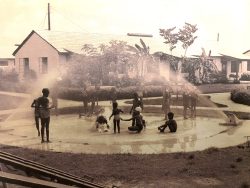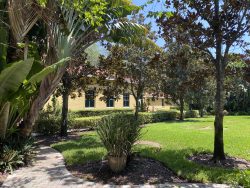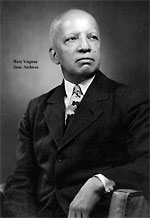About Us
News
Journeys in Journalism students share their experience visiting The Woodson
April 17, 2025
J. Hop Times and Spartan News Network

Students from Lakewood High School’s and John Hopkins Middle School’s Journeys in Journalism programs covered their visit to The Woodson where they met sculptor Wesley Wofford and participated in a workshop surrounding his sculpture, Beacon of Hope.
Click the links below to view what they documented.
History
 The Woodson African American Museum of Florida’s current building was previously the community center and an administrative office for the Jordan Park community, St. Petersburg’s first African-American community, and one of Florida’s oldest federal public housing projects.
The Woodson African American Museum of Florida’s current building was previously the community center and an administrative office for the Jordan Park community, St. Petersburg’s first African-American community, and one of Florida’s oldest federal public housing projects.
Jordan Park was founded by Elder Jordan, a philanthropist and community leader who was born into slavery in 1848 and purchased his freedom at the age of 15. He founded the community and created housing, a bus line, a beach, and the Jordan Dance Hall which is now known as the Manhattan Casino.
African Americans have played a crucial role in the growth and development of St. Petersburg since the late 1800s. The first African Americans came to this area seeking work. Many of the early migrants worked on the Orange Belt Railroad and other emerging enterprises. As St. Petersburg grew into a major tourist destination, more employment opportunities opened for these early residents. Settling near the downtown area to be near jobs and the railroad, African Americans established neighborhoods and the community grew, establishing independent institutions. Despite segregation and discrimination, the area thrived culturally.
In 1997, a Hope VI grant was awarded to the St. Petersburg Housing Authority in 1997, and this renovation of the original housing developments led to The Dr. Carter G. Woodson African American Museum being erected in 2006.
The museum changed its name to The Woodson African American Museum of Florida and announced a partnership with the Pinellas Community Foundation for its capital campaign in 2021. The goal is to construct a larger building that complies with core museum standards.

Mission & Impact
 Mission
Mission
The Woodson African American Museum of Florida seeks to preserve, present, interpret, celebrate and educate others regarding African American art, history, and culture throughout the state of Florida and beyond.
Impact
The history of African Americans in the St. Petersburg community and throughout the African Diaspora will be the central focus of programming at The Woodson African American Museum of Florida. The museum serves to preserve this rich history for present and future generations of St. Petersburg residents and visitors to St. Petersburg.
Who is Dr. Carter G. Woodson?
 The Father of Black History Month, Dr. Carter G. Woodson, was born in 1875 near New Canton, VA. He was the son of former slaves. In 1907, he obtained his BA degree from the University of Chicago. In 1912, he received his PhD from Harvard University.
The Father of Black History Month, Dr. Carter G. Woodson, was born in 1875 near New Canton, VA. He was the son of former slaves. In 1907, he obtained his BA degree from the University of Chicago. In 1912, he received his PhD from Harvard University.
In 1915, he and his friends established the Association for the Study of Negro Life and History. A year later, the Journal of Negro History, began quarterly publication. In 1926, Woodson proposed and launched the annual February observance of “Negro History Week,” which became “Black History Month” in 1976. It is said that he chose February for the observance because February 12th was Abraham Lincoln’s birthday and February 14th was the accepted birthday of Frederick Douglass.
Dr. Woodson was the founder of Associated Publishers, the founder and editor of the Negro History Bulletin, and the author of more than 30 books. His best-known publication is The Mis-Education of the Negro, originally published in 1933 and still pertinent today.
He died in 1950, but Dr. Woodson’s scholarly legacy goes on.
Space & Space Rental
 Museum space is available for individuals and organizations to schedule special events and meetings in the gallery, as well as outdoor events in our Legacy Garden. Opportunities for collaboration on joint projects and exhibits are encouraged and welcome.
Museum space is available for individuals and organizations to schedule special events and meetings in the gallery, as well as outdoor events in our Legacy Garden. Opportunities for collaboration on joint projects and exhibits are encouraged and welcome.
Leadership
Executive Director
Terri Lipsey Scott
Office Manager
Vanessa Sweat
Manager of Education, Outreach and Program Design
Patrick Arthur Jackson
Marketing and Communications Manager
Danny Olda
Docent
Lynnette Hardy
The Board
- Raymond Arsenault
- Frechette Bradley
- Kimberly Brown-Williams
- Chiquita Clark
- Roslyn Graham
- Yolanda Hudson